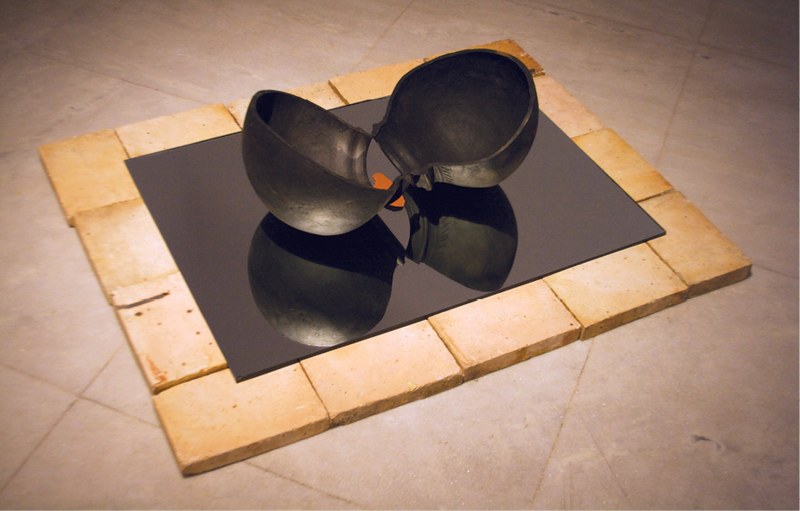
Dissected Projection, 1993
Wood, mirror, terracotta, and acrylic | 140 × 140 cm
One on One: Chitra Ganesh on Rummana Hussain
By Chitra Ganesh
Rummana Hussain (1952-1999) is widely considered one of India's foremost conceptual artists. I had the great fortune of seeing her last solo show before she died, "In Order to Join," held at Art in General in New York in October 1998. The exhibition was a culmination of a months-long residency, and the convergence of Hussain's work with this space was, in itself, extraordinary. The site-specific installation featured a projected video of her walking barefoot across the Queensboro Bridge (which connects Manhattan and Queens), combined with found objects such as hair and costume jewelry. The exhibition impacted me as a 23-year-old who had recently lost her mother, and Hussain's practice continues to move me. Her vision is more vital than ever in 2024's geopolitical climate, the waves of which are as evident in the art world as they are further afield, where we are constantly negotiating the implications of destruction and erasure.
Born into a prominent Muslim family, Hussain began her career as a painter working on canvas and paper. Both the artist and her practice were irrevocably transformed by the devastating events of 1992 in the town of Ayodhya in northern India when a centuries-old mosque, the Babri Masjid, was destroyed by an organized mob of Hindu extremists. At the time of its destruction, Hussain experienced the repercussions of incitement to violence against Muslims firsthand, became immersed in activism, and pivoted toward sculpture, performance, and installation. She then began to use her own body and materials, such as papayas and earthenware, to illuminate the fault lines of geography and the psyche, participating in collective resistance against the forces of religious nationalism through her work. My own work has drawn inspiration from Hussain's treatment of the body as a contested site of political and psychic rupture, and from her use of everyday objects—including signifiers of femininity such as jewelry and locks of hair—alongside materials such as a mirror and crumbled earth, as sculptural materials that link embodied resistance with quotidian life.
My second encounter with Hussain's work was at the Kiran Nadar Museum of Art (KNMA) in New Delhi in 2014 during an exhibition curated by Roobina Karoode, who explored artists' formal responses to trauma, historical memory, and site specificity, with a focus on works ruminating upon the aftermath of the Babri Masjid destruction. I saw two installations—Dissected Projection and Fragments from Splitting (both 1993)—and was struck by how the broken clay body became a potent signifier of multiple states at once: fractured collective consciousness, the fragmented body as a site of psychic rupture, and how inanimate shards have the ability to bear witness, amplified by mirror and dust.
Of all her works, I am most haunted by Is it what you think? (1998), a performance I have only come to know via its components and archival retellings as no comprehensive documentation of this work remains. It centered on a text that was, according to critic Geeta Kapur: "read by Rummana in a clear, matter-of-fact voice ... Rummana sat on a chair dressed in black lace undergarments and a sparkling parandi cascading from her long (false) plaited hair." As she spoke, images of Arab and Muslim women (alternately described as holding guns and in formations of protest) were projected onto her body, which was partially covered by a chador, draped in a way that revealed her mastectomy scars. After the reading, Hussain removed her chador and breast prosthesis and walked away.
Is it what you think? continues to radiate power in its afterlife. Hussain's prescient litany confronts us with contours of a female-bodied subject we may encounter, overlook, or willfully misrecognize. The artist moves fluidly between second- and third-person voice, a slippery mode of address that refuses audience members' status as neutral bystanders and evokes our complicity in its confrontation with discursive violence. "Have you defined her? Have you pushed her? How do you interpret that? ... Or have you deprived her of that description?" These questions point to the silent aggression of (y)our Western/Hindu/upper caste/hegemonic/liberal perspective.
Hussain's speculative text fleshes out an ever shape-shifting figure who defies the paradigms projected onto her body. She is an agent poised at the intersection of her engagement with labor, desire, patriarchy, violence, political awareness, health, rage, faith, autonomy, resistance, autoeroticism, and more, refusing the fixity of our gaze. The piece unmasks the hierarchies of power that inform the act of seeing and remind us that in the act of rendering a certain legibility to an unnamed, unknown, gendered subject, we become complicit in the epistemic violence within this gesture of seeing. Its trailblazing questions capture the dehumanization of the Muslim subject that lies at the heart of what has become commonplace in the post-Cold War production of the Muslim "other," as well as the War on Terror, now unfolding in horrifying detail in Gaza.
The dust and detritus of Hussain's unanswered questions continue to haunt the edges of today's livestreamed atrocities. They foretell the weaponization of religious, caste-based, and racialized violence, implemented alongside a double standard of who gets to be considered human, as a means to shore up political power. Her works are a vital reminder of how activism and bearing witness can grow an art practice and hone a formal language, and how speculative counternarratives are among the most potent means of resistance.